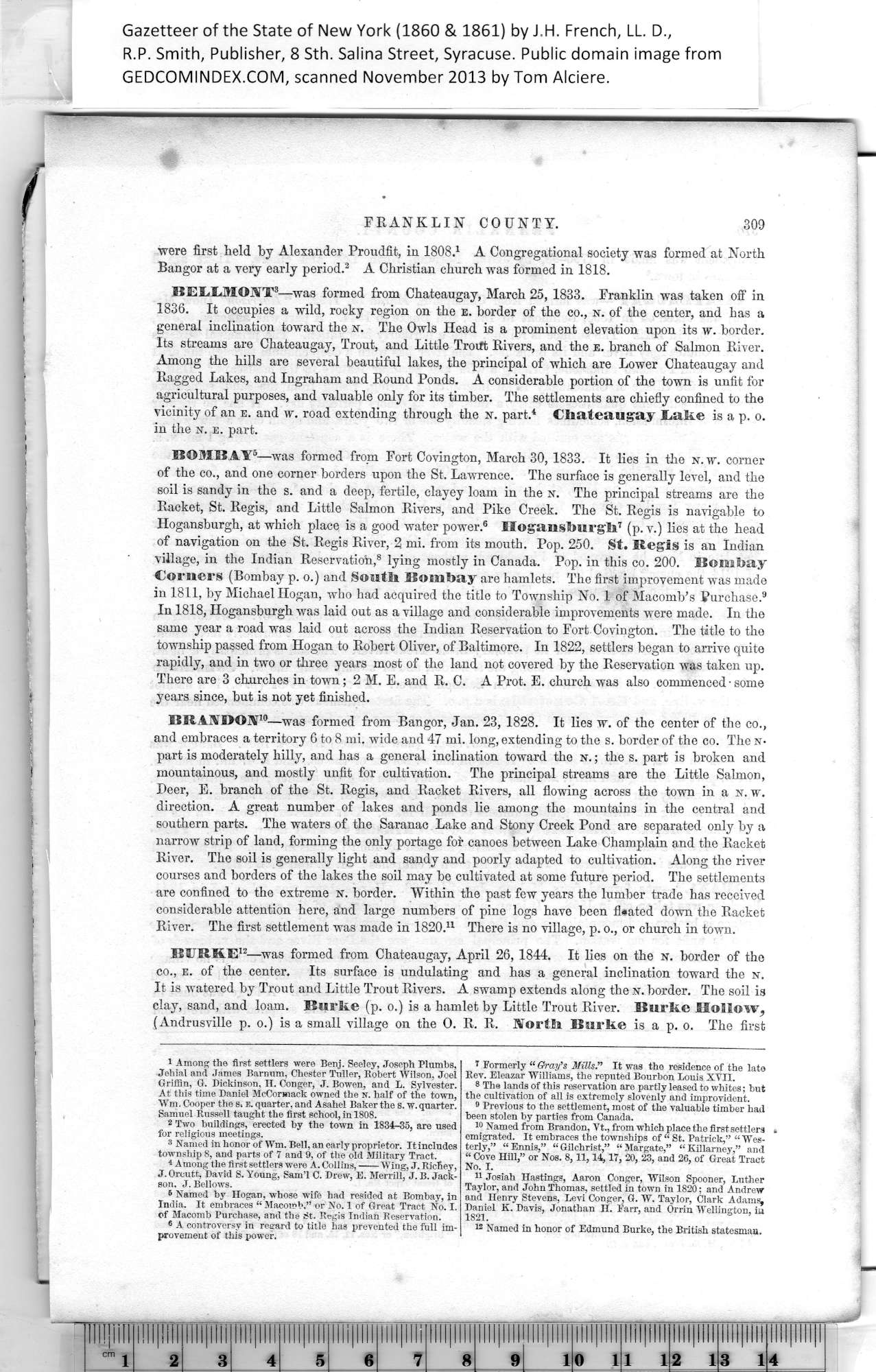|
FRANKLIN COUNTY. 309
were first held by Alexander Proudfit, in 1808.1 A Congregational society was formed at North
Bangor at a very early period.2 A Christian church was formed in 1818.
BEEEMONT3—was formed from Chateaugay, March 25, 1833. Franklin was taken off in
1836. It occupies a wild, rocky region on the E. border of the co., n. of the center, and has a
general inclination toward the n. The Owls Head is a prominent elevation upon its w. border.
Its streams are Chateaugay, Trout, and Little Trorft Rivers, and the e. branch of Salmon River.
Among the hills are several beautiful lakes, the principal of which are Lower Chateaugay and
Ragged Lakes, and Ingraham and Round Ponds. A considerable portion of the town is unfit for
agricultural purposes, and valuable only for its timber. The settlements are chiefly confined to the
vicinity of an e. and w. road extending through the N. part.* Chateaugay Cafe.© is a p. o.
in the n. e. part.
BOMBAY 5—was formed from Fort Covington, March 30, 1833. It lies in the n.w. corner
of the co., and one corner borders upon the St. Lawrence. The surface is generally level, and the
soil is sandy in the s. and a deep, fertile, clayey loam in the n. The principal streams are the
Racket, St. Regis, and Little Salmon Rivers, and Pike Creek. The St. Regis is navigable to
Hogansburgh, at which place is a good water power.4 Moganshurgh5 (p. v.) lies at the head
of navigation on the St. Regis River, 2 mi. from its mouth. Pop. 250. St. Regis is an Indian
village, in the Indian Reservation,8 lying mostly in Canada. Pop. in this co. 200. Boiaikay
Corners (Bombay p. o.) and Sontli Bombay are hamlets. The first improvement was made
in 1811, by Michael Hogan, who had acquired the title to Township No. 1 of Macomb's Purchase.9
In 1818, Hogansburgh was laid out as a village and considerable improvements were made. In the
same year a road was laid out across the Indian Reservation to Fort Covington. The title to the
township passed from Hogan to Robert Oliver, of Baltimore. In 1822, settlers began to arrive quite
rapidly, and in two or three years most of the land not covered by the Reservation was taken up.
There are 3 churches in town; 2 M. E. and R. C. A Prot. E. church was also commenced • some
years since, but is not yet finished.
BRAYDOY10—was formed from Bangor, Jan. 23, 1828. It lies w. of the center of the co.,
and embraces a territory 6 to 8 mi. wide and 47 mi. long, extending to the s. border of the co. The n*
part is moderately hilly, and has a general inclination toward the n. ; the s. part is broken and
mountainous, and mostly unfit for cultivation. The principal streams are the Little Salmon,
Deer, E. branch of the St. Regis, and Racket Rivers, all flowing across the town in a n.w.
direction. A great number of lakes and ponds lie among the mountains in the central and
southern parts. The waters of the Saranac Lake and Stony Creek Pond are separated only by a
narrow strip of land, forming the only portage for canoes between Lake Champlain and the Racket
River. The soil is generally light and sandy and poorly adapted to cultivation. Along the river
courses and borders of the lakes the soil may be cultivated at some future period. The settlements
are confined to the extreme n. border. Within the past few years the lumber trade has received
considerable attention here, and large numbers of pine logs have been floated down the Racket
River. The first settlement was made in 1820.u There is no village, p. o., or church in town.
BURSAE12—was formed from Chateaugay, April 26, 1844. It lies on the N. border of the
co., e. of the center. Its surface is undulating and has a general inclination toward the n.
It is watered by Trout and Little Trout Rivers. A swamp extends along the n. border. The soil is
clay, sand, and loam. 15is2■ Sie (p. o.) is a hamlet by Little Trout River. Burke Hollow,
(Andrusville p. o.) is a small village on the 0. R. R. Nor til Burke is a p. o. The first
|
I Formerly “ Gray's Mills.” It was the residence of the late
Bev. Eleazar Williams, the reputed Bourbon Louis XVII.
8 The lands of this reservation are partly leased to whites; but
the cultivation of all is extremely slovenly and improvident.
9 Previous to the settlement, most of the valuable timber had
been stolen by parties from Canada.
10 Named from Brandon, Vt., from which place the first settlers »
emigrated. It embraces the townships of “ St. Patrick,” “ Wes¬
terly,” “Ennis,” “Gilchrist,” “Margate,” “Killarney,” and
“ Cove Hill,” or Nos. 8,11,14,17, 20, 23, and 26, of Great Tract
No. I.
II Josiah Hastings, Aaron Conger, Wilson Spooner, Luther
Taylor, and John Thomas, settled in town in 1820; and Andrew
and Henry Stevens, Levi Conger, G. W. Taylor, Clark Adams,
Daniel K. Davis, Jonathan H. Farr, and Orrin Wellington, in
1821.
Named in honor of Edmund Burke, the British statesman. |
1
Among the first settlers were Benj. Seeley, Joseph Plumbs,
Jehial and James Barnum, Chester Tuller, Bobert Wilson, Joel
Griffin, G. Dickinson, H. Conger, J. Bowen, and L. Sylvester.
At this time Daniel McCormack owned the N. half of the town,
Wm. Cooper the s. e. quarter, and Asahel Baker the s. W. quarter.
Samuel Bussell taught the first school, in 1808.
2
Two buildings, erected by the town in 1834-35, are used
for religious meetings.
3
8 Named in honor of Wm. Bell, an early proprietor. It includes
township 8, and parts of 7 and 9, of the old Military Tract.
4
A controversy in regard to title has prevented the full im¬
5
provement of this power.
|
